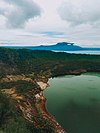Masungi Georeserve

This article needs to be updated. (September 2022) |
| Masungi Georeserve | |
|---|---|
 The Sapot web-style view platform at the Masungi Georeserve | |
 | |
| Location | Baras, Rizal, Philippines |
| Coordinates | 14°36′18″N 121°20′19″E / 14.60500°N 121.33861°E |
| Established | 1996 |
| Governing body | Masungi Georeserve Foundation |
| Website | Masungi Georeserve |
The Masungi Georeserve is a conservation area in the Philippines situated in the southern Sierra Madre range in Baras. It centers on the geological formations of Masungi Rock, at an elevation of 640 metres (2,100 ft).[1] In 1993, the Masungi Rock and its vicinity was proposed to be declared as a Strict Nature Reserve and Wildlife Sanctuary. It has been a popular destination for hikes and day trips from Manila and started development towards Geopark status.
Description
[edit]The Masungi Georeserve is located at Kilometer 47, Marilaque Highway, Baras, Rizal, Philippines. The Masungi Georeserve is characterized by rugged limestone karst peaks, steep slopes, and surrounding lush montane rainforests. It contains several caves, including the Yungib ni Ruben (Ruben's Cave), which features stalactite and stalagmite formations, as well as a man-made fountain.[2]
A popular attraction in the park is the Sapot ("Cobweb"), a metallic platform with wooden steps which allows visitors to walk on suspended netting above the karst and get a 360-degree view of the Sierra Madre and Laguna de Bay.[2] The park's tallest peak, Tatay, also has a viewing deck at its summit. The limestone formations are connected by hanging bridges, rope courses and eco-trails developed by the Masungi Georeserve Foundation and Blue Star Development.[3] On one of the hanging bridges, a wooden cable car-like shelter called Patak ("water droplet") can be found which serves as a rest stop for visitors. The Duyan, a giant rope hammock spanning a few hundred feet, is one of Masungi's most photographed rope courses.[2]
The park was formerly a component of the Mariquina Watershed Reservation from its creation on July 26, 1904 to Oct. 29, 1973.[4] In 1993, the Masungi Rock and its vicinity was proposed to be declared as a Strict Nature Reserve and Wildlife Sanctuary by the Department of Environment and Natural Resources.[5]
In July 2024, the Department of Environment and Natural Resources officially announced plans to nullify the 2017 memorandum of understanding with Masungi Georeserve Foundation Inc. through secretary Gina Lopez following doubts raised on its constitutionality. Leonardo DiCaprio appealed to President Marcos, Jr. to protect Masungi.[6]
Biology and ecology
[edit]Masungi is home to 400 species of flora and fauna including birds, insects, cloud rats, monitor lizards, snakes, monkeys, and civets.[3][7] Cycas riuminiana, a cycad endemic to Luzon, also grows in Masungi.[8]
In 2017, a new subspecies of microsnail, Hypselostoma latispira masungiensis, was discovered on the limestone boulders of Masungi Georeserve. The park is the only known habitat of the newly discovered subspecies.[9][10]
The park is also famous for its salinggogon or Philippine cherry blossoms which bloom seasonally.[11]

Trail specifications
[edit]It has been a popular destination for hikes and day trips from Manila since it opened in 2015 and started development towards Geopark status.[3] The Masungi Georeserve only allows a limited number of guests to go through the conservation area at their request. An experienced park ranger guides guests throughout the trek, providing in-depth information about the sustainable tourism industry in the Philippines.

External links
[edit] Media related to Masungi Georeserve at Wikimedia Commons
Media related to Masungi Georeserve at Wikimedia Commons
References
[edit]- ^ "Masungit Rock, Province of Rizal, Calabarzon". Geonamebase.com. Retrieved 10 January 2017.
- ^ a b c Reyes, N. (27 March 2016). "A first-timer's guide to Masungi Georeserve, where adventure awaits". Rappler. Retrieved 10 January 2017.
- ^ a b c Evangelista, C. (27 November 2016). "Exploring Rizal's Masungi Georeserve". Philippine Daily Inquirer. Retrieved 10 January 2017.
- ^ "Presidential Decree No. 324, s. 1973". Official Gazette (Philippines). Retrieved 10 January 2017.
- ^ "Administrative Order No. 33" (PDF). Department of Environment and Natural Resources. Retrieved 10 January 2017.
- ^ Vergara, Christine (July 4, 2024). "DiCaprio joins call for Masungi protection". The Manila Times. Retrieved July 5, 2024.
- ^ Limos, Mario Alvaro (December 7, 2020). "The Cry of Masungi: How the Battle Rages for This Piece of Paradise". Esquire Philippines. Summit Media. Archived from the original on December 7, 2020. Retrieved January 15, 2021.
- ^ De la Cruz, Christa (July 9, 2020). "These Prehistoric Plants in the Philippines Are Older Than Dinosaurs". Esquire Philippines. Summit Media. Archived from the original on January 15, 2021. Retrieved January 15, 2021.
- ^ Malig, Kaela (October 6, 2020). "Filipino scientists discover new microsnail subspecies at Masungi Georeserve". GMA News. Archived from the original on October 9, 2020. Retrieved October 9, 2020.
- ^ Lipae, Harold B.; Estabillo, Angelique L.; Fontanilla, Ian Kendrich C.; De Chavez, Emmanuel Ryan C. (August 12, 2020). "A new subspecies of microsnail from Masungi Georeserve, Rizal, Philippines" (PDF). Philippine Journal of Systematic Biology. 14 (3). Association of Systematic Biologists of the Philippines (ASBP): 1–12. doi:10.26757/pjsb2020c14003. ISSN 2508-0342. S2CID 226975073. Retrieved October 9, 2020.
- ^ De La Cruz (2023). LOOK: Philippines' Own Version of Sakura Are in Full Bloom Near Manila. Spot.ph.
